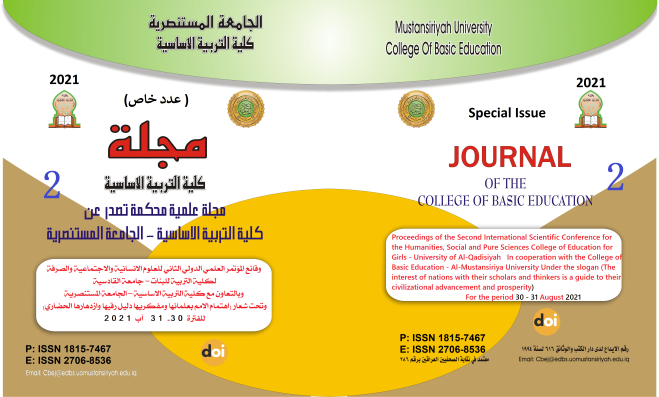cial teachers at the secondary stage in light of the concept of total quality and the challenges of the ageTeaching methods used by so
Main Article Content
Abstract
In the recent period, there have been many complaints about the prevailing education system and its programs in many parts of the world, including the third world, especially in the Arab world and Iraq in particular, which led to high shouts and criticism directed at educational institutions, accusing them of failing to teach students and how they use their brains. Despite the efforts made by the institutions and despite the quantitative and qualitative transformations that are taking place on them, their curricula, activities and teaching methods are still relatively insufficient in developing sound thinking methods for our students, as their curricula and evaluation methods still depend on memorization methods and preservation of information and facts, and the learner remains the negative role in the educational process He is content with receiving what is imposed on him in the prescribed books, and he must accept everything that is presented therein without criticism or research (Atiya 2006: 55). After examining the researcher in detail about the methods used in the field of teaching in secondary education by being a teacher in the Directorate of Education Al-Qadisiyah, it became clear to him the neglect and the lack of use of these institutions for modern teaching strategies, which in turn led to a decrease in the academic achievement of students and then a decrease in the scientific level in the subjects in general. And in the subject of history in particular, where the low scientific level is one of the main problems of education, which negatively affected the students, the family and society. When the concept of total quality appeared in education, work in educational and educational institutions, including secondary education, began to apply this concept, which keeps pace with modernity, in a very serious manner, in order to develop the performance of these educational institutions, especially in the field of teaching and its methods, as well as the administrative aspects that contribute to promoting the application of this concept, taking from its success In other fields, a method and an incentive to solve the difficult problems that hindered and hindered the work of these institutions, adopting the goals of total quality, which stipulate the preparation of a student with certain specifications that help him to be able to keep pace with the advancement of knowledge and information and the rapid change and technological progress in the world. The application of the concept of total quality has positive effects in developing the knowledge product, raising the scientific level of students and improving the performance of teachers, as its application requires an organized direction for all its human cadres and its educational curricula with all its elements, including teaching methods. Organizing and scientific balancing of the various factors involved, including the nature of the student, the teaching materials and the educational situation
The teacher does not study with his subject as much as he is creative in his performance and quality, which is evident from his teaching method and the style used during his teaching of a specific subject in making education an interesting, interactive and interesting education that does not contain cost and craftsmanship, in order to achieve the educational goals set for him in advance (Al-Fatali, 2016).
In light of the foregoing, this research can be summarized as follows
1- Determining the difficulties facing secondary education in the application of total quality, especially in the subject of social studies
2- Discussing the factors that lead to the development of secondary education
3- To highlight the role of the concept of total quality management and its importance in the growth and development of education and the establishment of an educational base concerned with education in detail
4- Providing recommendations that can contribute to overcoming the obstacles that stand in the way of secondary education in the application of total quality
In this research, the researcher followed the descriptive analytical desk research method and reached a set of conclusions, including:
1- The teacher’s dependence in secondary education on traditional teaching methods, such as lecture, recitation, extended explanation, filling and indoctrination, which leads to students’ mind wandering and makes them passive in the educational situation. specific ,
2- It also became clear to the researcher the rigidity of the curricula for social subjects and their elements, including teaching methods, the low cultural level, the systematic awareness of modernity and the logic of renewal and contemporaneity for civilizational knowledge progress. In light of the conclusions reached by the researcher, he recommended some recommendations, the most important of which are:
1- Spreading the culture of the concept of total quality, its tools and techniques through training, education and publicity for it
2- Continuous evaluation of all components of the educational process, including curricula, faculty members, administrators, supervisors, and all educational environments.
3- The necessity of changing the social studies curricula and making them more attractive through directing and printing, taking into account illustrative and representative images, and resorting to the concept of stories, especially in historical materials.
Article Details

This work is licensed under a Creative Commons Attribution-ShareAlike 4.0 International License.
